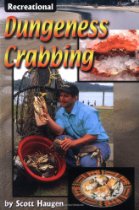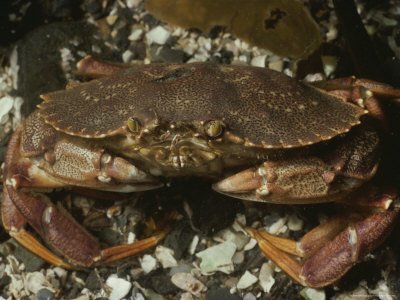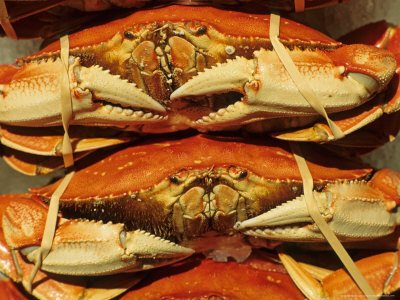Crabbing on the Oregon Coast
Catching Crabs
Buy (or rent) a crab ring from one of the numerous merchants on the Oregon Coast. Ensure that it is equipped with a float and sufficient line to reach the river bottom: 10 to 12 feet, if crabbing from the dock; about 30 feet if crabbing from a boat on the river.
If the current is running hard, the crab will bury themselves at the river bottom and won’t be lured to the bait. Try to pick a time within an hour of high or low tide, when the current is slack.
Fish carcasses work best as bait, and should be available from local bait shops. Secure the bait to the bottom of the ring. Lower the baited ring to the river bottom. Upon reaching the bottom, the ring will collapse, allowing the crab to enter the ring. Leave the baited ring in place for approximately 20 minutes.
After the elapsed time, raising the ring quickly will trap the crab in the ring (slowly raising the ring will allow the crab to escape the ring), Immediately sort thru any trapped crabs and release any crabs that are too small, or the wrong gender (see Rules and Regulations below). Transfer legal Dungeness crab that have been caught to a bucket or pail filled with salt water. Crab should be kept alive until it is time for cooking.
The most widely accepted method of cooking crab is in salt water. Ensure the pot is sufficient in size to allow plenty of space to cook the crab; don’t squeeze them into a small pot or inadequate amount of water. Add salt to the water and bring the pot to a rolling boil on the stove or campfire.
Depending on the size of your crab pot, drop the live crab into the boiling water, one at a time. This is the most humane method to kill your catch (death is instantaneous), and the safest for human consumption (no potential toxins are released into the crab meat). Allow sufficient room for each crab to boil freely. If the pot is overcrowded, the water will cool resulting in cooking conditions that are less than ideal.
Cook the crab for about approximately 10 minutes, starting the elapsed time after the water has returned to a full boil. Overcooking will yield crabmeat that is dry and stringy. Once cooked, the crab shell will turn pink. Remove the cooked crab from the water and let cool before cleaning.
Cleaning Crabs
Cleaning the crab is easy, once you have the know-how. Snap off the outer shell; place your fingers under one edge and give it a tug. It takes neither great coordination nor Herculean strength. Remove the gills, and the yellowish organs with your fingers under running water. If you let the water do all of the work, some of the delightful flavor will be lost. Just dig in and do it! A gentle rinse with water is a good idea.
Crab meat is extremely perishable. The crab should be kept alive until it is cooked, cleaned immediately after cooking, and kept on ice until ready for eating. Plan your crab feast typically within 24 hours of your catch. If you would like to eat your crab hot, simply place the cleaned crab into boiling, salted water for a moment or two.
Suggestion: Dungeness crab has a mild, delicate flavor. Although it would enhance practically any seafood recipe, try eating the crab just by itself cold, right out of the shell, or hot, dipped into drawn butter.
Rules and Regulations
A license is required all persons over the age of 14 for the harvesting of shellfish Dungeness crab that may be kept are male crabs, measuring a minimum of 5 3/4 across the widest part of the shell (minus the points).
The daily catch limit is 12 crab per licensed individual. It is unlawful to retain more than two daily catch limits (i.e., 24) in a live trap or live box. Additionally, it is unlawful to mutilate crab such that the sex, size, or species cannot be determined prior to landing, or to transport mutilated crab across state waters. To get an ODFW license and learn all the rules and regulations, start by finding a place to buy a ODFW license.

Crabbing is one of the Pacific Northwest’s most enjoyable pastimes. The thrill of pursuing these cagey creatures is justly rewarded with savory table fare. A sport that can be shared with the entire family, crabbing continues to grow in popularity.
Some of Oregon and Washington’s best crabbing waters are highlighted, along with cleaning and preparation procedures, as well as some delicious recipes. Whether you’re a beginner or veteran crabber, the knowledge shared in these pages is sure to increase your catch.
Where to get Dungeness Crab:
Alsea Bay
Coos Bay
Coquille River
Necanicum Bay
Nehalem Bay
Siletz Bay
Siuslaw River
Tillamook Bay
Netarts Bay
Nestucca Bay
Umpqua River
Yaquina Bay
Where to get Red Rock Crab:
Coos Bay
Tillamook Bay
Netarts Bay
Nestucca Bay
Yaquina Bay


